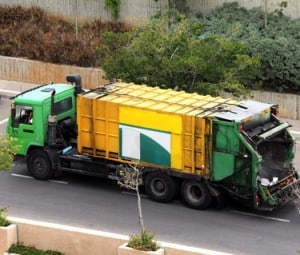
Eighty percent of U.S. products are used one time and then are discarded, GrowNYC reports. In 2011, recycling and composting help to prevent 86.9 million tons of material, nearly 30 percent of which was paper and paperboard, from entering landfills, according to the EPA. In a comparison of the average cost of garbage services and recycling services, it is sometime surprising to find that recycling services cost more than curbside garbage pick-up services do.
The Missouri Department of Natural Resources explains that many times, what appears to be a higher cost is simply a line item error in data presentation. The true cost of garbage pick-up is not always reflected in the presented line item cost because cities and other municipalities pay contract fees to hauling companies, transfer stations, and even out-of-state landfills from a different area of the budget. Often, when you add in those other costs for garbage pick-up, the curbside service for garbage become much higher than the fees charged for recycling.
The perspective objective
Carl Menger said a “product’s value is determined by the demand for it by consumers in the marketplace, and its marginal supply.” In short, the value of recycling is determined by the demand for what is recycled, and the volume of the recycled item in comparison to its demand. How do we compare the cost of recycling to its value? Cost is also subjective. According to the EPA, it costs more to open a new landfill than it does to use an existing landfill. Therefore, recycling, which helps to keep reusable material out of landfills, actually helps to save money off the cost of opening new landfills. Cost is subjective.
More than 40 percent of New York municipal discards (by weight) consists of packaging such as plastics, paper, cups, diapers, junk mail, and paper towels, says GrowNYC. Clearly, consumer choice when purchasing products has an impact on the cost of recycling. Have you noticed that in some stores, they now charge you a recycling fee for certain products? The overall cost of recycling is difficult to figure out because the variables are so subjective. How much does it cost to regrow a forest that was harvested to make paper? How much does it cost to drive garbage trucks from New York City to New Jersey because New York City does not have landfills? To carry the garbage from Manhattan to New Jersey requires that diesel trucks drive 7.8 million miles each year. That amount of driving is equal to driving 312 times around the entire planet. What does it cost to clean the air of all the CO2 emissions from driving 312 times around the earth?
A great example of the difference between products is the comparison of satellite Internet providers and land-based Internet providers. With satellite internet service, you have a small box that connects your computer to the Internet. With land-based internet service, you have a small box that connects your house to the Internet and millions of miles of plastic coated wires, copper wires and other precious resources that are used just to bring Internet service into your home. There are a lot of products that will be discarded with land-based Internet suppliers, but not much product to be discarded with satellite providers.
Consumers play a role
What we buy has a direct impact on what we throw out, and what we recycle. We can choose to buy products that have less packaging, or we can continue to pay more for recycling. In so doing, we help to reduce the discarded waste. The hidden cost of recycling is a matter of perspective.


